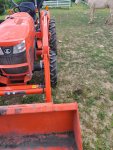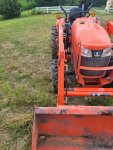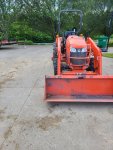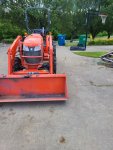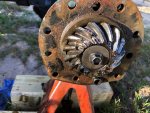yeah and they do just wear out. Almost all tractors (4wd) use the same type of system, or very similar. There are a few radial ball bearings that support the weight of the entire tractor. Radial ball bearings do a good job of supporting a radial load (perpendicular to the shaft that the bearing is on) but a very very poor job of supporting a axial (thrust, or sideways) load. Therein lies the issue. They'll support the axial but the load rating is really low in comparison to the radial. Tractors are always used in such ways that the bearings are supposed to deal with both radial and axial loading. Then a lot of them, if you flip the tires or widen the front end via spacers or whatever, the axial load goes up tremendously, which then shortens the bearing's life by applying more axial load than it is designed for. This is common with tractors that have a loader. The solution would be to redesign the entire front axle and both hubs but then the hubs become much bigger, MUCH more expensive, heavier, more complex, honestly becomes a worst case scenario for everyone including the manufacturer, dealer, end user, and the person who's got to work on them.
Lawn mowers are a good example. Woods used a lot of spindle bearings that were tapered rollers, but they required a lot more power to turn them in comparison to a ball bearing. Almost everyone uses ball bearings. They work for a long time so long as they're not full of moisture and/or dirt but even perfect conditions they're not gonna last forever. The blades have a ramp (wing) on them that lifts the grass and generates airflow under the deck. The blade also has weight. The combination of the weight and the wing forces the blade downward while rotating which loads the bearings axially. Woods bearings last, gosh, forever as long as they have a little grease in them, but they're tapered rollers which are designed to support the load; but as said they also need more power to run them because of their design. Similarly, cars. Used to be all cars had tapered roller bearings for wheel and hub bearings. Nowadays, they're mostly hub assemblies, if you take one apart they're usually a double row radial ball bearing which "rolls" easier (much easier) which in turn offers better fuel economy. The downside is that they cost more and they're harder to put in, and you can't really rebuild them (not the home mechanic anyway).


